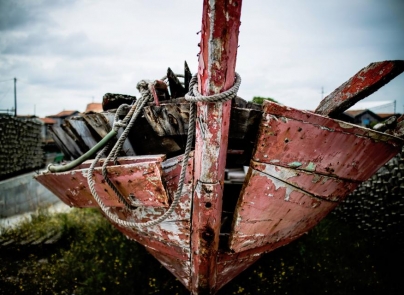Radegund of Thuringia – Giving Refuge to Women in Violent Times

Radegund of Thuringia – Giving Refuge to Women in Violent Times
In 531, an army of Frankish soldiers invaded the Kingdom of Thuringia (in today’s France), sacked the palace, killed the royal family, and took the royal children back to the Frankish capital, Athies. Among these children was Radegund, daughter of Bertachar, who had ruled Thuringia jointly with his brothers until one of them killed him. At the time of the Frankish conquest, she was living in the home of her father’s murderer.
Theuderic and Chlotar, co-rulers of the Frankish kingdom, divided the spoils. Clothar, who had a reputation for being “most amorous by temperament,” won Radegund in a gambling game, and raised her as future member of his harem of six wives and at least one concubine.
Officially, Theuderic and Chlotar were Christians. Their father Clovis had been converted through the intervention of his wife Clotilde. But conversions of rulers, at that time, were often political in nature, and their actions didn’t always follow their professions of faith.
We don’t know anything about Radegund’s beliefs at the time of her arrival. Thuringia was still a pagan region but Christianity might have been introduced at her court. In any case, in Clothar’s palace she was baptized and raised as a Christian with other children. She learned to sing Psalms and received a basic education that allowed her to read the Scriptures and the writings of the church fathers.
Radegund’s Escape
By 1540, when Clothar, now in his forties, took her as his wife, her life was so devoted to prayer, study, and works of charity that he complained that he had married a nun. There were times when she left the conjugal bed to go “to relieve nature” and he would find her prostrate on the floor in prayer. During the royal banquets, she would often leave to take food to the poor.
Most likely, Clothar objected to these practices. Although his opposition has not been documented, the reference in one of Radegund’s poems to “the captive maid given to a hostile lord” might have been an indication.
This situation continued for about ten years, until Clothar murdered her brother. Then she left the palace and found temporary refuge with the bishop of Noyon, Médard, surprising him with the unusual request to consecrate her to God as a nun.
This put Médard in a difficult situation. He wanted to help her, but married women could not legally become a nun. When Radegund insisted, he consecrated her as a deaconess.
After this, she retired in a castle in Saix, in southern France, which Clothar had given her as morgengabe, the customary present noblemen offered to their wives after their first wedding night.
Clothar was not about to let Radegund go. Whatever her feelings might have been toward her, she had brought him dishonor. Besides, their union was important to him from a political point of view, sealing his victory over Thuringia. He then asked Germanus, bishop of Paris, go with him to Saix to take back his bride.
But Radegund was a step ahead of him. Alerted by some courtesans of the king intentions, she approached Germanus and asked him to intervene in her favor. Her letter to him might have included some details of marital abuse, because Germanus asked Clothar to repent. In the end, he was able to convince the king not only to let Radegund go, but to finance the founding of an abbey she could preside.
Apparently, Clothar allowed some of Radegund’s ladies-in-waiting to follow her. Radegund, who refused the title of abbess, gave it to one of her ladies, Agnes, whom she had “loved and brought up as if she were [her] daughter from her childhood onwards.”[1]
A Place of Refuge
While renouncing the title of abbess, Radegund exercised a strong influence on the running of the abbey, starting with its initial conception as a refuge for women in violent times. “I asked myself,” she later explained, “with all the ardor of which I am capable, how I could best forward the cause of other women, and how, if our Lord so willed, my own personal desires might be of advantage to my sisters.”[2]
Abuse against women was common in those days – whether by their husbands or as a consequence of wars. Clothar’s father, Clovis, blamed Clotilde for the death of their first son, who died soon after the baptism she requested, and continued to scorn her until his conversion.
The Visigothic princess Galswintha, who passed by Radegund’s abbey on her way to her marriage to Chilperic I, the Merovingian king of Neustria, was later murdered in unclear circumstances, apparently on the instigation of one of Chilperic’s mistresses. At that point, Galswintha’s daughter Basina to find refuge in Radegund’s abbey.
Later, after the death of Clothar, some his remaining wives became victims of the bloody contest for power.
Besides providing protection, Radegund gave the nuns time and means for pursuing a higer education. In fact, every nun was required to devote at least two hours a day to reading and copying Scriptures and manuscripts. One of them, Baudonivia, composed a biography of Radegund after her death – one of the few surviving works written by women at that time.
Radegund the Woman
Baudovinia wrote her biography soon after the poet and bishop Venantius Fortunatus wrote a similar work, Her reasoning was that she wanted to include details the bishop had missed.
One of these details described a moment when Radegund, still a queen, traveled by a place of pagan worship and ordered her men to burn it down. What’s more, she stayed not only to make sure it was completely burned, but also to pacify the protesters with her explanations.
Baudovinia goes on to describe Radegund’s motives behind her actions. For example, the reason for her abounding generosity toward the poor was that “she believed that anything the poor received of her was their own in reality.”[3] This followed the thought of Church Fathers such as Clement of Alexandria, Chrysostom, and Ambrose, possibly showing her knowledge of their writings.
Like Fortunatus’s biography, Baudovinia’s is hagiographic, including stories of miracles – although most of the miracles were simple answers to prayers for common things, such as the expelling of a “raucous night bird” that “troubled the peace of the nuns.”[4]
The only recorded admonishment to Radegund is found in a letter by Caesaria, abbess of Arles: “It came to me that you abstain too much. Do everything reasonably.”[5] After all, Caesaria said, if Radegund exceeded in her ascetic life, there would come a time when, to restore her health, she would have to accept not only food, but the very “delicacies” she had been trying to avoid.
The only writings we have by Radegund are her letter to the bishops and three poems (that she might have written together with Fortunatus). Two of the poems are addressed to relatives and express her anguish over the evils of war and the death of her loved ones. They include little consolation – only a few, brief, concluding words of prayer for Christ to hear her cry and for her loved ones to be “happy in broad present health and future salvation.”[6]
But if Caesaris’s letter is any indication of the customary communication between these nuns, we can assume that Radegund’s thoughts were so filled with Scriptures that she could pour them out one after another in her everyday speech.
But if Radegund erred in her ascetism, she also knew how to entertain her friends. The warmest descriptions of Radegund’s friendly exchanges are found in the letters Fortunatus wrote to her in poetic form. A frequent visitor to her abbey, he considered Radegund and Agnes family members. He often called Radegund “mother” (in spite of being less than ten years younger than her) and Agnes “sister.”
In one of his most affectionate letters, he regrets missing Radegund’s birthday and talks about small presents he sent her: “what I could, little apples, small blackberries.”[7] Another time, he describes a basket he had woven with his own hands and filled with chestnuts for the nuns. He also sent violets and crocus flowers to honor Radegund with the colors of the purple and gold she had abandoned for Christ. “Though the grace of the flowers of paradise awaits you,” he says, “these wish to see you now outside.”[8]
Radegund’s appreciation for flowers is obvious in Fortunatus’s description of the flower arrangement she and Agnes brought to the altar: “Here the golden order with saffron [crocus], the purple goes out with violets, here scarlet reddens, there milk white makes snowy. There is blue with green: colors fight with the flower and in that place of peace you think herbal wars. Here it pleases with white, there it vibrates with red beauty. Thus various sprouts of flowers battle with each other in beauty, so that color conquers jewels, scent conquers incense. You who have constructed this, Agnes and Radegund, may your scent breath forth eternal flowers.”[9]
Of Fortunatus’s fifty-five letters/poems to Radegund, at least fifteen refer to food or meals. When he was sick, they sent him milk or entire meals, including a rich meat stew. When Radegund was not well, he encouraged her to drink wine.
These poems help us to balance the images of Radegund the iconoclast, the ascetic, and the saint. So do her poems to her relative Amalfred and her nephew Artachis, revealing her need for family connections. They help us to gain a well-rounded picture of this Christian woman who lived in a world most of us find difficult to even imagine.
[1] Marcelle Thiebaux, The Writings of Medieval Women: An Anthology, Routledge, Taylor & Francis Group, second edition, 2019. See also Medieval Women’s Latin Letters, https://epistolae.ctl.columbia.edu/letter/914.html
[2] Ibid.
[3] Jo Ann McNamara, E. Gordon Whatley, John E. Halborg, eds., Sainted Women of the Dark Ages, Duke University Press, 1992, 87.
[4] Ibid., 64, 100.
[5] A letter from Caesaria, https://epistolae.ctl.columbia.edu/letter/915.html
[6] A letter from Radegund to Artachis, https://epistolae.ctl.columbia.edu/letter/917.html
[7] A letter from Fortunatus to Agnes and Radegund, https://epistolae.ctl.columbia.edu/letter/953.html
[8] A letter from Fortunatus to Radegund, https://epistolae.ctl.columbia.edu/letter/921.html
[9] A letter from Fortunatus to Radegund, https://epistolae.ctl.columbia.edu/letter/920.html





